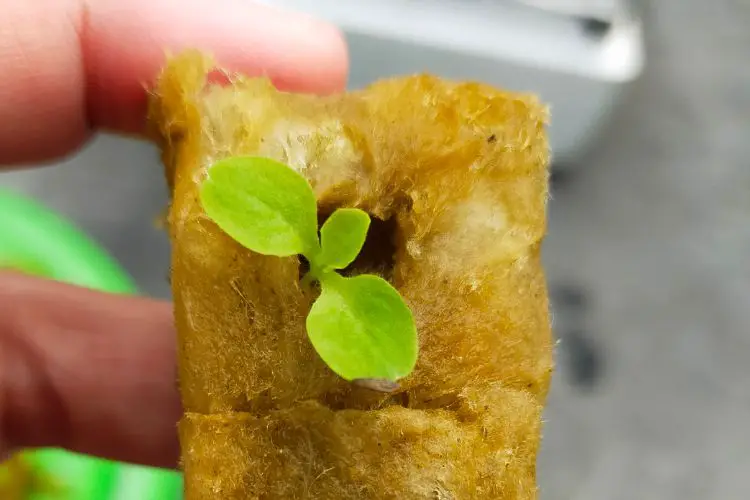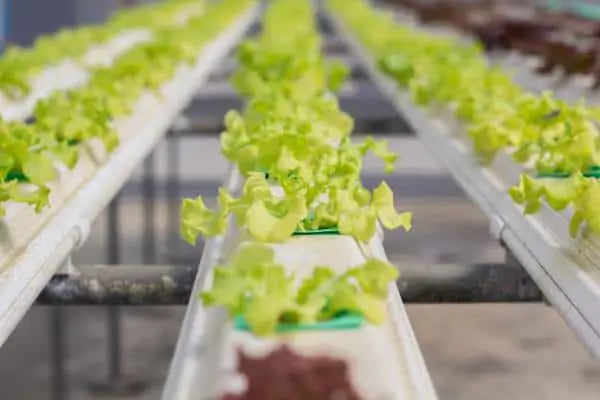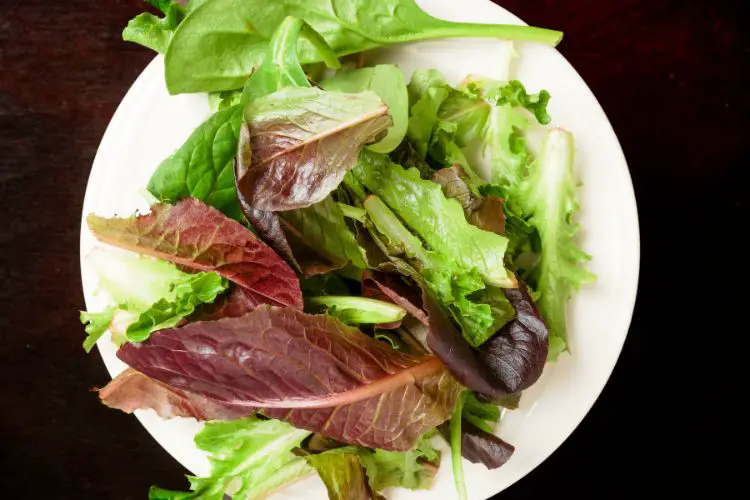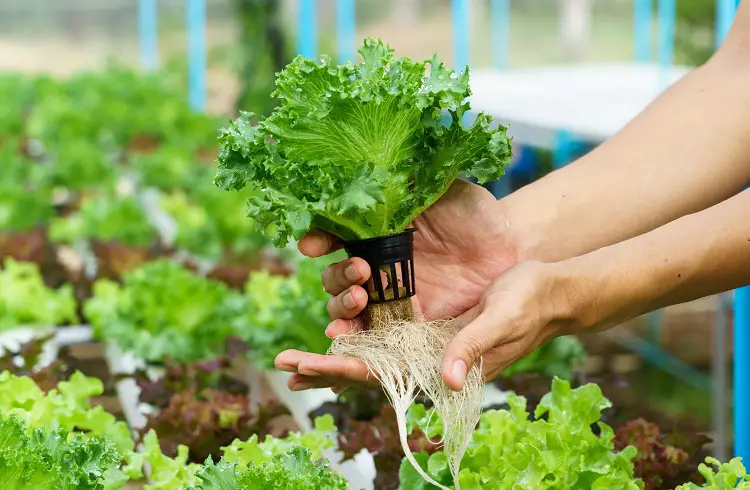Lettuce is one of the most popular vegetables that’s a nutritious delicacy for everyone from Ancient Egypt to outer space [1]. It’s also the best plant to grow in my home garden because it’s easy to achieve high yields with proper care.
Growing lettuce with a hydroponic system requires a combination of growth medium, light, nutrition, and temperature. I find hydroponic lettuce is an excellent starter crop to learn how the system works.
So, here’s how to grow hydroponic lettuce.
A Place for Your Hydroponic Garden: Indoor or Outdoor
Where you grow your hydroponic lettuce is a critical factor.
For starters, hydroponics are appropriate for indoor spaces or greenhouses. But the system is also suitable for outdoor spaces.
Lettuce doesn’t require strong lighting to thrive, so it is advisable to grow the vegetable indoors.
Next, consider the garden size when choosing an indoor spot.
Hydroponic System for Growing Lettuce
You can build a DIY hydroponic system, but there’s no reason to when there are multiple, premade, and affordable designs on the market.
These systems help you grow the most delicious lettuce possible.
However, what works for one home garden might not be the best for you. It’s critical to consider the different choices available.
A few factors go into choosing the best system for your indoor hydroponic lettuce garden, including:
- The amount of space available
- Your budget
- Number of plants you require
Start small and expand in the future. Too many lettuce plants can be overwhelming for the beginner, especially when you run into issues.
Take your time to learn a little about each method—you might find one that’s easier to set up in your space.
Here are systems to consider while learning how to grow hydroponic lettuce indoors.
Deep Water Culture
In a Deep Water Culture system (DWC), you suspend the plant’s roots in an oxygenated solution of water and nutrients.
The nutrient solution contains:
- Oxygen—The water needs to be well-oxygenated because the roots are not in the soil. Oxygenation occurs with the help of an air pump and an air stone.
- Water—This is a significant reason why hydroponic growing is beneficial—you’ll never “water” again.
- Nutrients—The best quality contains all the macro- and micronutrients a plant requires to thrive. Since the system doesn’t have soil, you supplement the water with nutrients.
In a Deep Water Culture system, the roots are submerged in the water. This is why an air pump and air stone are required components of the system. Other methods will expose the root zone to air and therefore don’t need the air pump.
Nutrient Film Technique
The Nutrient Film Technique (NFT) uses a water pump to deliver the nutrient solution to your lettuce. Gravity helps guide the water back to the main reservoir. The NFT system is active because it requires moving parts to work.
The best NFT system allows the nutrient solution to flow over the roots. Only a small amount of water flows through the channels, hence the “film” term. This setup allows the lettuce to get sufficient oxygen without drowning.
Ebb And Flow System
The Ebb and Flow system will not expose the roots constantly to a nutrient solution. Instead, you place the plant in a tray with a growing medium. You flood the tray with the nutrient solution a few times daily.
After flooding, gravity carries the solution back to a reservoir for oxygenation using an air pump and air stone. It will sit there until the next flooding cycle. The Ebb and Flow is a simple system to build and use, making it an excellent option for both commercial growers and beginners.
The Kratky Method
The Kratky method was developed by the University of Hawaii researcher Bernard Kratky [2]. You don’t need a pump to circulate water and nutrients with this hydroponic system. Instead, it works via a stagnant hydroponic solution and air space.
The water level drops as your lettuce grows, creating air space for the roots. You don’t have to replenish the nutrient-filled water as it is used up by the time the plant is ready for harvesting. You calculate the amount of solution your lettuce will require and fill the reservoir only once.
Set Up Your Hydroponic System
Once you have decided on the system you will use, the next step to growing your hydroponic lettuce is setting up the design.
That said, here are instructions and requirements for setting up each system to grow your lettuce hydroponically:
- Deep Water Culture—The system requires a nutrient and water reservoir, net pots for your lettuce, pH adjusters, hydroponics nutrients, an air pump, and air stones.
- Nutrient Film Technique—The system involves more materials, including PVC pipes, brackets, lumber, a submersible pump, and an air pump.
- Ebb and Flow—Some parts to build the system are a flood tray, an analog or digital timer, and overflow and inlet fittings.
- The Kratky method—It is the easiest and best hydroponic system for lettuce to put together. It consists of six simple steps that include a container and a growing medium.
Hydroponic Grow Medium For Lettuce
You need to put hydroponic lettuce roots directly into water to thrive. This means choosing a medium that allows seedlings to sprout while offering physical support to the roots. Phenolic foam and stone wool, also known as rockwool, are ideal for germinating your lettuce.
Phenolic foam boasts an excellent water-retention capacity and is the best for rapid germination crops such as lettuce. Rockwool has up to 25% air in its impressive water retention capacity, which helps the root system gain more oxygen.

The Best Grow Lights For Your Hydroponic Lettuce
Growing hydroponic lettuce indoors requires emulating the conditions the plant might experience outdoors. This includes offering supplementary lighting for the right duration. Grow lights are an excellent solution.
Light exposure is a critical factor for growing plants because it helps with the photosynthesis process. The best grow hydroponics lights are full-spectrum lamps or LED grow light systems in white, blue, and red light options.
Metal-halide lights can provide your plants the full spectrum light because they are rich in the blue end light, which is vital for growing healthy lettuce [3].
Hydroponic LED grow lights use less electricity and don’t produce heat as a sight effect. LEDs have a long lifespan and are significantly bright. Hang these lights a few inches above the lettuce and raise them as the plants get taller.
Choose the Variety of Lettuce
You can grow just about all lettuce hydroponically. There are 2 main types of lettuces: head lettuce and looseleaf lettuce.
Head lettuces grow in a tight head of leaves and the whole head is harvested. Looseleaf lettuces grow in loose clumps and are harvested earlier than head lettuce by harvesting the young leaves. Below are some common lettuce varieties grown hydroponically.
Butterhead Lettuce
Butterhead lettuce, also called Bibb lettuce, is a head lettuce variety. It features buttery and soft leaves. The texture and taste of this variant make it a popular choice for sandwiches, lettuce wraps, and salads.

Butterhead lettuce sub-variants include Boston, which features a rose flower-like head.
Butter heads don’t require much water, making them an excellent choice when you have a cramped space or want to conserve water. This lettuce also requires minimal lighting.
Romaine Lettuce
Romaine lettuce is also a head lettuce and is the most popular lettuce variety for hydroponics beginners. This plant is hardy, and the leaves are highly nutritious, tasty, and crisp. It is the key ingredient in Caesar salads.
Romaine requires less water than your typical in-ground vegetables, making it an environmentally friendly option. You can plant this variant at three-week intervals for a steady supply of lettuce ready to harvest.
Looseleaf Lettuce
Looseleaf lettuce is an excellent option for both beginners and experienced hydroponics growers. Examples of looseleaf lettuce varieties are Black-seeded Simpson and Oak Leaf.
Looseleaf lettuce is one of the simplest plants to grow. Plant, add your medium, add water, and harvest!

Get Started Growing
Choosing the plant as your starter crop is an excellent way to learn how to grow lettuce in a hydroponic system. It also ensures you have a steady supply of leafy vegetables.
The key to getting a good crop is a healthy regime from the start. This includes germinating the lettuce seeds to transplanting the seedlings.
Seed Germination
Use small trays to start your lettuce seedlings for the hydroponic system. Fill the trays with moistened growing medium. However, only add enough water to make the medium wet and not soggy.
Next, sprinkle lettuce seeds and cover with a quarter inch of moistened growing medium. Lightly press down for optimal soil-to-seed connection. Apply light water or mist to keep the medium moist during germination.
Place seedlings under fluorescent lighting once they emerge. Maintain a two-inch height above the lettuce with 14-hour artificial light hours. After the seedlings are about two inches tall, thin to the strongest plants.
Read more: How To Germinate Seeds For Hydroponics
Transplanting Seedlings
The home grown lettuce seedlings should be ready for transplanting to your hydroponic environment after about seven to ten days. Roots at the bottom of the containers show the plants are ready for transplanting. Several roots mean the lettuce is strong enough to survive the rigors.
However, ensure you give the lettuce seedlings good watering the night before transplanting them. This ensures the roots absorb enough water. Further, transitioning from a soil environment to a water one will be easy.
Place your grow light panels at least eight inches from the lettuce for proper growth. When adding your water and solution, leave an inch of air space between the water and the bottom of the panels.
Care and Maintenance
The crispy, green vegetable plant is easy to grow, but the correct methods of maintaining it are critical. Here are three care and maintenance tips that will groom you into a hydroponic lettuce expert with harvests all year round and minimal failure chances.
Hydroponic Lettuce Light Requirements
Lettuce is a low-light demand plant. You can grow it in a hydroponic environment without direct sunlight, just about 10 to 12 hours of light daily.
However, lettuce can’t stand full sun. Exposure to intense sunlight accelerates lettuce growth to its bolt or flowering phase and becomes bitter. So, avoid planting hydroponic lettuce near windowsills or outdoors.
Best Temperature for Hydroponic Lettuce
Different lettuce varieties thrive in cool temperatures between 68 and 75 degrees Fahrenheit during the day and 60 to 65 degrees at night when germinating them. Lower the temperature slightly after the plants establish themselves, keeping it to 75 degrees during the day and 55 degrees Fahrenheit at night.
Hydroponic lettuce requires specific temperature levels, so ensure you know how to take care of it. The wrong air temperature can cause stunted growth or bitterness. The right temperature ranges enable your lettuce to grow into healthy vegetables that taste good.
Best Nutrients for Lettuce Hydroponics
It’s essential the nutrient solution for your hydroponic lettuce is well-balanced and provides all the vital plant nutrients. The three primary nutrients are NPK:
- Nitrogen—A critical component for chlorophyll for absorbing light and sugar as you grow lettuce hydroponically
- Phosphorous—The component responsible for new growth, developing the roots, and lettuce maturity
- Potassium—For the overall health of your hydroponic lettuce plant
However, maintain a balance of nutrients for healthy leafy lettuce. The solution should also contain boron, iron, calcium, manganese, magnesium, and iron. Choose a hydroponic nutrient mix specifically for lettuce to ensure you’re offering the best combination.
Feed your lettuce every seven to ten days and monitor the nutrient levels daily because the strength can change as the plants absorb water. Some varieties feed voraciously and require frequent feeding, so adjust feeding as they grow hydroponically. It’s advisable to use Electrical Conductivity (EC) meters to check when the nutrient content is low, high, or just right [4].
Read more: How to Test EC in Water
Harvest Your Hydroponic Lettuce
Hydroponic lettuce is popular because most varieties grow fast, and you can harvest mature leaves more than once. Most types have healthy and fresh leaves ready for harvest within six to eight weeks, depending on the hydroponic system for lettuce you adapt.
Some growers remove the root system and everything else to prepare lettuce for sale. Consider cutting the whole head above the root for immediate use and dispose of the root system. However, remove leaves at the base if they are not as crisp as you want.
Conclusion
Learning how to grow hydroponic lettuce at home offers plenty of benefits, and you can cultivate multiple varieties with your system. The plant is fast-growing and has low light requirements. So be assured of an all-year supply of nutritious leafy greens.
References:
- https://www.nationalgeographic.com/culture/article/from-ancient-egypt-to-outer-space-the-delicious-history-of-lettuce
- https://www.ctahr.hawaii.edu/hawaii/downloads/three_non-circulating_hydroponic_methods_for_growing_lettuce.pdf
- https://caas.usu.edu/labs/cpl/files/photobiology.pdf
- https://www.ndsu.edu/agriculture/extension/publications/using-electrical-conductivity-and-total-dissolved-solids-meters-field-test



